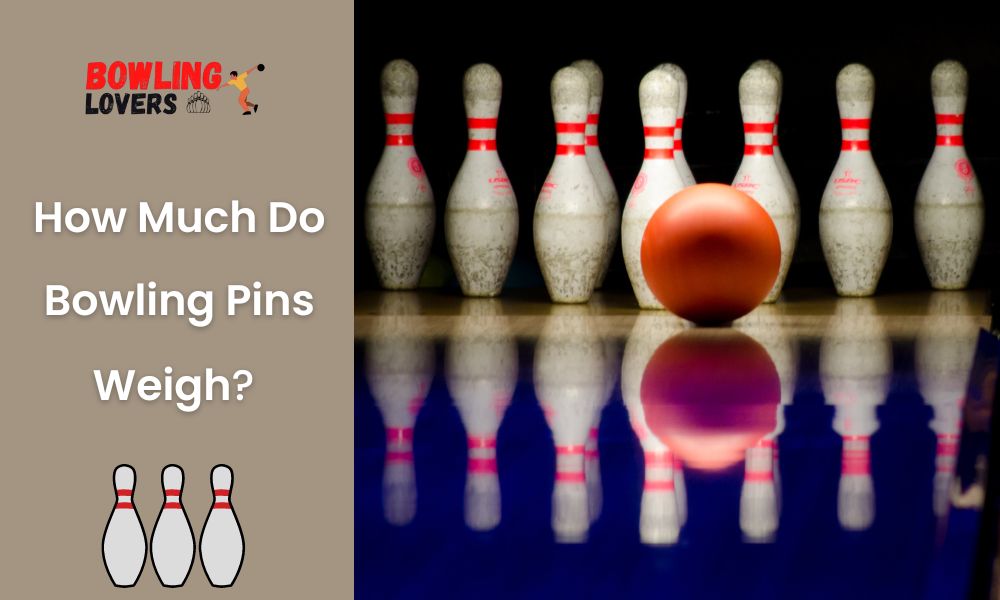Bowling is a popular and beloved sport that involves precision, skill, and strategy.
While most people focus on the bowler and the ball, the humble bowling pin also plays a crucial role in the game.
Have you ever wondered about the weight and dimensions of bowling pins and how they vary among different types?
This article will explore the fascinating world of bowling pin weight and dimensions, exploring the variations among types of bowling pins and their impact on the game.
So, let’s roll into the details and uncover the hidden secrets behind these seemingly simple yet essential objects on the bowling lane.
How much do Bowling Pins Weigh?
Ten-Pin
The most common form of bowling is played in the United States and many other countries.
Ten-pin bowling pins are typically made of hard maple wood.
The standard regulation weight of a ten-pin bowling pin is 3 pounds and 6 ounces (1.5 kilograms), with a maximum weight of 3 pounds and 10 ounces (1.6 kilograms).
Candlepin
Primarily played in New England, Canada, and some parts of the United States.
Candlepin bowling pins are slender and cylindrical with a small, cylindrical top, and they are typically made of hard maple wood
Candlepins are tall and thin, measuring 15+3⁄4 inches (40 cm) in height, 2+15⁄16 inches (7.5 cm) in width, and weighing 2 pounds and 8 ounces (1.1 kilograms).
Duckpin
Primarily played in the eastern United States and Canada.
Duckpin bowling pins are shorter and squatter than ten-pin or candlepin bowling pins. They are typically made of hard rubber or synthetic materials.
Duckpins measure 9.4 inches (23.87 cm) in height, 4.75 inches (12.06 cm) in diameter, and weigh around 1 pound and 12 ounces (0.79 kilograms).
Nine-Pin
Primarily played in Europe, particularly in Germany, Austria, and Switzerland. Nine-pin bowling pins are usually made of solid wood.
Nine-pins are slightly larger than ten-pin bowling pins and weigh around 4 pounds and 6 ounces (1.98 kilograms).
Five-Pin
Primarily played in Canada. Five-pin bowling pins are small and squat, and they are typically made of hard maple wood or synthetic materials.
Five-pin bowling pins are short and squat, measuring 12 inches (30.48 cm) in height, 3 inches (7.62 cm) in diameter, and weighing around 3 pounds and 6 ounces (1.5 kilograms).
| Type of Bowling Pin | Weight (lbs) | Weight (kg) | Height (inches) | Height (cm) | Diameter at Widest Point (inches) | Diameter at Base (inches) |
|---|---|---|---|---|---|---|
| Ten-Pin | 3.6 | 1.5 | 15 | 38.1 | 4.75 | 2.03 |
| Candlepin | 2.5 | 1.1 | 15 3/4 | 40 | 2 15/16 | 2.125 |
| Duckpin | 1.75 | 0.79 | 9.4 | 23.87 | 4.75 | n/a |
| Nine-Pin | 4.375 | 1.98 | 17.5 | 44.45 | 5 | 3.35 |
| Five-Pin | 3.375 | 1.5 | 12 | 30.48 | 3 | n/a |
Bowling Pins Dimensions
Ten-Pin
Overall diameter: 4.75 inches (12.06 cm), Base diameter: 2.03 inches (5.16 cm), Overall height: 15 inches (38.1 cm).
They typically have a narrow neck that connects the top and bottom sections.
Candlepin
Height: 15+3⁄4 inches (40 cm), Width at widest point: 2+15⁄16 inches (7.5 cm), Top and bottom width: 2.125 inches (5.4 cm).
Candlepin bowling pins are slender and cylindrical with a small, cylindrical top.
Unlike ten-pin bowling pins, candlepin bowling pins do not have a distinct neck.
Duckpin
Height: 9.4 inches (23.87 cm), Diameter: 4.75 inches (12.06 cm), Hole in the center: 1.5 inches (3.81 cm) in diameter.
Duckpin bowling pins are shorter and squatter than ten-pin or candlepin bowling pins.
Duckpin bowling pins also do not have a clear distinction between the top and bottom sections.
Nine-Pin
Diameter widest point: around 5 inches (12.7 cm), Diameter at base: 3.35 inches (8.5 cm), Height: 17.5 inches (44.45 cm).
They are generally taller and more slender than ten-pin bowling pins.
Five-Pin
Height: 12 inches (30.48 cm), Diameter: 3 inches (7.62 cm), Hole in the center: 1.5 inches (3.81 cm) in diameter.
They have a distinctive squat shape with a wider base and a narrower top.
It’s worth noting that these are the standard dimensions for each type of bowling pin, but there may be variations depending on the specific rules or regulations of different bowling associations or individual alleys.

Frequently Asked Questions
Why are Bowling Pins Shaped the Way They Are
Firstly, their shape is designed to ensure that they remain stable and upright until they are struck by a bowling ball.
Another reason for the specific shape of bowling pins is that they are designed to be easily reset after each frame.
Their cylindrical shape and uniform size make it easy for automatic pinsetters to pick them up and place them back into position.
Additionally, the spherical shape of the pins allows them to roll and strike other pins in a multitude of directions, making each strike unique and unpredictable.
Are Bowling Pins Hollow?
Yes, bowling pins are hollow. This not only makes them lighter and easier to handle but also allows them to bounce back more easily when struck by a bowling ball.
The pin’s shell is made of durable plastic material, usually polyethylene or polyester resin, which is thick enough to provide durability but light enough to keep the overall weight within the regulation limits.
The hollow design also helps to ensure consistent pin action by minimizing the effect of vibrations and ensuring that every pin behaves the same way when hit by a bowling ball.
Are there any standards for bowling pin weight and dimension?
Yes, there are standards for bowling pin weight and dimension. In the United States, these standards are set by the United States Bowling Congress (USBC), which is the national governing body for bowling.
According to USBC regulations, a regulation bowling pin must have the following dimensions:
– Overall height of 15 inches (38 cm).
– Overall diameter of 4.75 inches (12.06 cm).
– Base diameter of 2.03 inches (5.16 cm).
The mass or weight of a bowling pin is also regulated by the USBC. A regulation bowling pin must weigh between 3 pounds and 6 ounces (1.5 kilograms) and 3 pounds and 10 ounces (1.6 kilograms).

Conclusion
The weight and dimensions of bowling pins play a crucial role in the game of bowling.
Whether you’re playing ten-pin, candlepin, duckpin, nine-pin, or five-pin bowling, understanding the standard dimensions and weight of the pins is essential for a successful game.
From the towering pins of ten-pin bowling to the slender and cylindrical pins of candlepin bowling, and the unique squat shapes of duckpin, nine-pin, and five-pin bowling, each type of pin has its own distinct characteristics that add to the excitement and challenge of the game.
So, keep an eye on those pins next time you hit the lanes and appreciate their impact on your bowling experience!

